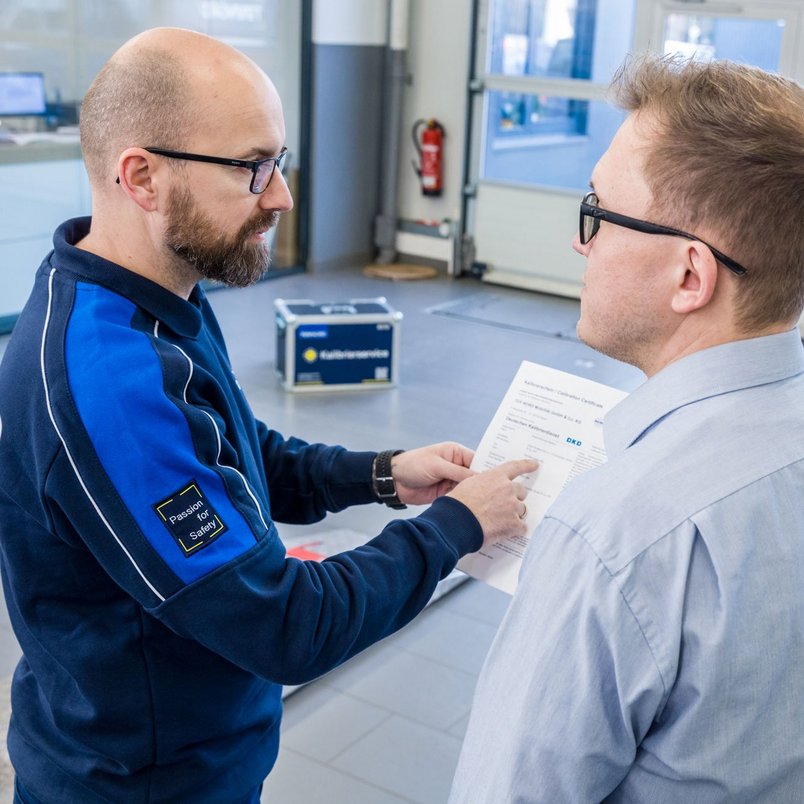Car dealership and workshop
Calibration of headlight adjustment test system
TÜV NORD offers you professional calibration of headlamp alignment systems to ensure that your workshop always meets the highest safety standards.
Order calibration now
Car dealership and workshop
TÜV NORD offers you professional calibration of headlamp alignment systems to ensure that your workshop always meets the highest safety standards.
Order calibration now
Headlamp alignment systems consist of
We offer accredited calibration for almost all common headlight alignment testers.
This applies to both analogue and digital devices. However, the software version of the installed firmware sometimes determines whether calibration is possible.
Please let us know when order when placing your order so that we can clarify all the necessary questions.

Order your desired calibration quickly and easily using the online form.
In addition to the calibration of headlamp alignment systems, TÜV NORD Mobilität also offers type testing for headlamp alignment units.
If you would like more information, please contact the following e-mail address baumuster@tuev-nord.de.
There are many different requirements for SEPS. Please use our contact form so that we can clarify all your questions together. Alternatively, you can use the following detailed description as a first point of reference.
Firstly, it is important that the SEP has a valid type approval with the approval number on the type plate so that the calibration can be completed successfully.
In addition to calibrating the light adjustment device, it is also necessary to check both mounting surfaces.
Unfortunately, the detailed requirements for SEPS are currently quite complicated due to various transitional periods and depend on the commissioning date.
In general, the longitudinal and transverse inclination as well as the evenness of the two surfaces are checked.
In addition, the SEP is checked for functionality and accuracy. A positive calibration certificate can only be issued if all aspects are assessed positively.
Specific requirements:
Firstly, there are two different requirements for the number of measuring points to be recorded when measuring the vehicle footprint, depending on the date of commissioning of the SEPS:
The evenness of the vehicle footprint must fulfil the requirements of DIN 18202:2005 for "ready-to-use floors with increased requirements" (see DIN 18202:2005 Table 3 and Fig. 5, line 4). In simplified terms, this means
The flatness deviation of the SEP installation surface must not exceed ± 0.1 % (corresponds to ± 1 mm/m). This means that the inclination of the carriage of the headlight alignment tester must not change by more than ± 0.1 % over the entire travel distance.
If the SEP is able to compensate for the unevenness of the SEP installation surface during the HU (when travelling from one lane to another), this requirement can be disregarded.
The requirements for headlamp alignment testers have remained largely unchanged. The SEP must have a type approval and have an accuracy of 0.2 %.
Sources:
[1] Verkehrsblatt 23-2018 No. 174, "Guideline for checking the adjustment of motor vehicle headlights during the main inspection in accordance with Section 29 of the German Road Traffic Licensing Regulations (StVZO) (HU headlight inspection guideline)", November 2018
[2] DIN 18202:2005, "Tolerances in building construction - Structures", April 2013
Headlamp alignment systems, consisting of a headlamp alignment unit and mounting surfaces, must be checked before initial commissioning and then regularly (at least every 24 months) (in accordance with Traffic Bulletin 23-2018 No. 174).
Recalibration is necessary after every intervention in the measurement recording.
In accordance with the applicable headlamp test guidelines, the requirements for the evenness of the SEP installation surface can be disregarded if the unevenness can be compensated for via settings on the SEP (levelling function).
For this purpose, the SEP must be able to be levelled by the test engineer during the HU in order to compensate for the unevenness of the SEP installation surface in front of the headlights of the vehicle to be tested. In principle, this is possible with both analogue and digital light adjustment devices.
If the evenness requirement for the SEP installation surface is not met, a solution may be to rework the floor, upgrade your device or purchase a levelling device. Please do not hesitate to contact us.
All points of the routine test are checked as part of our calibration procedure and documented in the calibration certificate.
An additional routine test is therefore not necessary if the calibration is carried out by TÜV NORD Mobilität.
All SEPS used as part of the HU must have a valid calibration certificate at the time of the test.
SEPS that are not calibrated are therefore no longer permitted for the HU.
At TÜV NORD Mobilität, we offer you customised calibration services that ensure the efficiency and safety of your workshop equipment. Our experts ensure that your equipment always meets the highest standards. Discover our key services: